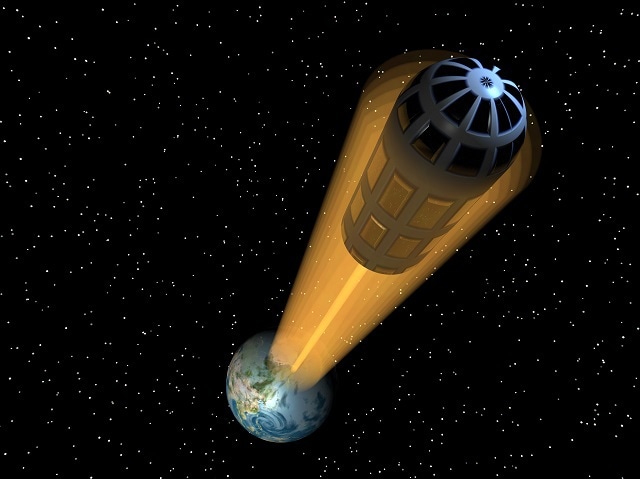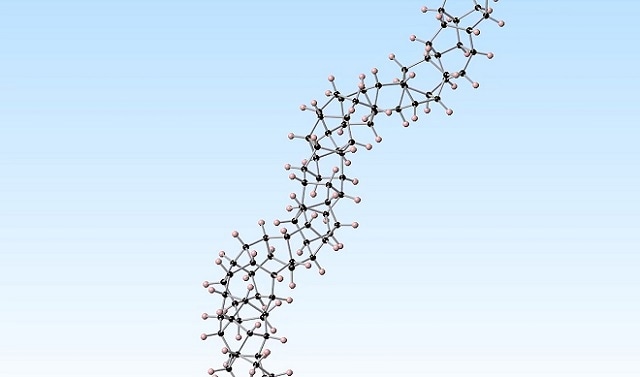
Image Credit: Jerry Lyles | Shutterstock.com
A space elevator may sound like an idea that could only exist in science fiction but we may be closer to seeing one in the near future than you might have previously thought.
2050: A Space Odyssey
A Japanese company, called Obayashi Corporation, recently announced that it intends to build a fully working space elevator by the year 2050. This space elevator would drastically reduce the risks and costs associated with space travel in the future. A space elevator would act as a direct transport route to the frontier of space.
Diamond Nanothreads
The space elevator still has a lot of theoretical challenges to overcome before it can be realised. Currently the largest challenge facing the space elevator project is the creation of a cable that would be strong enough to support the immense forces that it would be subjected to.
Advances in research into nanotechnology and carbon nanotube materials are now presenting us with the opportunity to create a cable that could actually handle the forces that would be exerted on it.
Researchers are currently exploring the idea of using ‘diamond nano-threads’ as the material of choice for a space elevator cable. These nanothreads, which are currently being developed by John V. Badding and his research team at Penn State University, have a unique structure compared to other carbon nanotubes.
John Badding, professor of chemistry at Penn State, talks about his research.
John Badding, Professor of Chemistry at Penn State, Talks About his Research
The unique structure which diamond nanothreads have is achieved by compressing benzene, a ring of six carbon atoms, causing the benzene to stack. Eventually the pressure becomes too much and the benzene breaks apart, only to reform again in the shape of a tetrahedron as the pressure is slowly released by the scientists.
One of our wildest dreams for the nanomaterials we are developing is that they could be used to make the super-strong, lightweight cables that would make possible the construction of a space elevator which so far has existed only as a science-fiction idea.
John V. Badding, Professor of Chemistry at Penn State University
Badding’s team are the first to develop a structure in which tetrahedrons, pyramids with a triangular base, are connected end by end in order to form an incredibly strong structure.
Creating Incredibly Light and Incredibly Strong Cables
The strength of a diamond nanothread means that this nanomaterial could be used to create the cables of a space elevator. The cables need to be both incredibly light and incredibly strong in order to provide the stability required for a space elevator to operate.
Diamond nanothreads would be ideal for this use due to their stiffness and strength, as well as the fact that they are light in weight. However, currently used processes and techniques to create carbon nanotubes have limitations and are not yet able to produce the quantity or quality of nanomaterials which a space elevator cable would require.
However, the Obayashi Corporation believes that large scale production technology will have been established by 2030, leading them to predict that they could complete their space elevator project by 2050. The construction of a cable is the first step in creating a space elevator because it requires the most research in order to be fully realised.

Diamond Nanothreads - Image Credit: John Badding Lab | Penn State University
The Main Components of a Space Elevator
The other four main components required to build a space elevator are:
- an anchoring station placed on the surface of the earth
- a counterweight in space which will help stabilise the orbit of the cable
- a mechanical lifter to pull the elevator up the cable
- a power source located on the earth to deliver power to the elevator
The Anchoring Station
The anchoring station will serve as a starting base for space elevator missions and will most likely originate from a location in the Pacific Ocean. Using a location on the surface of the Pacific Ocean would allow the anchoring station to move along the ocean surface to help the cable avoid any threatening objects. A location along the equator in the Pacific Ocean would also help to minimise the threat that extreme weather could pose to the space elevator and its operation.
The Counterweight
The counterweight helps to stabilise the space elevator by keeping the cable at its maximum length and tension as it orbits around the earth. Researchers believe that the ideal counterweight could be the same spacecraft which will be used to launch the cable into space. This dual purpose spacecraft/counterweight would help to minimise the economic costs of the counterweight and the spacecraft delivering the cable.
An Elevator to Space: Markus Landgraf at TEDxRheinMain
An Elevator to Space: Markus Landgraf at TEDxRheinMain
The Mechanical Lifter
The mechanical lifter will work in conjunction with the cable to provide the elevator with its vertical motion. One of the potential designs for the lifter is a series of rollers with traction tread that would look something similar to the rollers on a tank. These rollers would pull the cable through the space elevator and thus pull the elevator upwards into space.
The Power Source
The power source will wirelessly deliver power from the anchoring station to the space elevator as it makes its journey upwards towards space. This can be done by firing a laser at photovoltaic cells, which will convert the energy from the laser into electricity that the mechanical lifter can use.
Whilst the concept of wirelessly transferred power sounds like something straight from the pages of a science fiction novel, we have been using microwaves to fly model aircraft for over 20 years.
Some Challenges to Overcome
Even if all of these components work in unison there are still a number of challenges that need to be overcome in order to create a working space elevator. For example, low earth orbit objects could potentially damage or cut the cable that the space elevator is using. If the cable was to be cut it could fall back to the earth and cause enormous damage to the anchor station and the surrounding area.
Another major concern which has to be considered is the political impact of creating a space elevator. If the space elevator’s anchor station is situated in international waters, then who would own the space elevator and how would you equally share the usage of the space elevator? These are just a few of the issues which have to be resolved before the space elevator becomes a reality.
Why is it Worth the Effort?
The current cost of transporting cargo into space using spacecraft is around $20,000 per kilogram. Using a space elevator, Obayashi claims that this cost will be drastically reduced to just of only a few hundred dollars per kilogram of cargo. Apart from the obvious benefits of transporting material into space in a more cost effective manner, a space elevator also has huge applications for space launches.
Michio Kaku on the Space Elevator
Overcoming the Earth’s gravitational field and atmosphere is one of the major costs and difficulties associated with a space shuttle launch. However, if a space elevator could transport a spacecraft into space ready to be launched, then the effects of gravity and atmosphere would no longer pose a challenge to space travel in the future.
The development of a space elevator represents an important first step towards travel and exploration into deep space, as well as opening up the possibility of a civilisation that spans our solar system.
References and Further Reading
Disclaimer: The views expressed here are those of the author expressed in their private capacity and do not necessarily represent the views of AZoM.com Limited T/A AZoNetwork the owner and operator of this website. This disclaimer forms part of the Terms and conditions of use of this website.